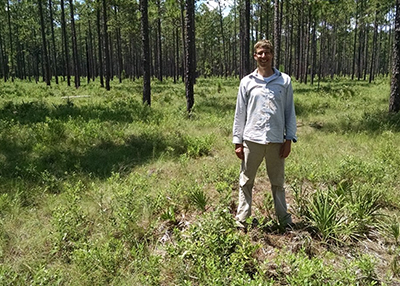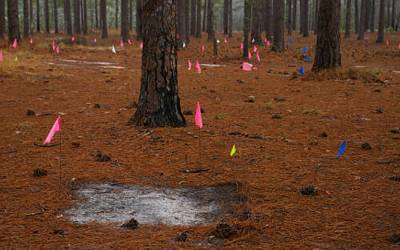MSU, UW-Madison show straightforward step can help restore biodiversity hotspot
New research from Michigan State University and the University of Wisconsin-Madison shows that, for all the complexities and challenges of ecosystem restoration, simple first steps can still go a long way.
The team showed that degraded savanna ecosystems scarred by decades or centuries of human activity can reap lasting benefits from a single seeding of native understory plants. Published this week in the journal Proceedings in the National Academy of the Sciences, the study underscores the long-term value of even a brief burst of targeted land management.

Michigan State University plant biologist Lars Brudvig stands in a high-quality longleaf pine savanna at one of the research team’s study sites. Credit: Ellen Damschen
“These findings help to guide the restoration of imperiled longleaf pine ecosystems by illustrating the lasting biodiversity benefits of one-time plant reintroductions, showing when, where and why these efforts will be most successful,” said Lars Brudvig, a professor of plant biology in the College of Natural Science at MSU.
Brudvig helped lead the project along with ecologists John Orrock and Ellen Damschen professors of ecology, at UW-Madison.
The eight-year experiment centered on three large tracts of federal land within the historical range of the longleaf pine savanna ecosystem. Longleaf pine savanna dominated portions of the southeastern United States prior to the arrival of Europeans.
This biodiversity hotspot once spanned some 90 million acres but has largely vanished. Less than 5 percent of the continent’s longleaf pine savanna remains, and much of what does persist is a shadow of the unspoiled ecosystem of the past.
“In a high-quality longleaf stand, you can find over 30 species in a square meter. It’s incredible,” said Orrock, who is first author of the new paper.

An experimental plot at Fort Bragg in North Carolina shows how devoid of plant life a highly degraded longleaf pine understory can be. This photo was taken at the beginning of the experiment before the seed additions had time to establish. Credit: W. Brett Mattingly
The longleaf stands where the researchers set up their experiment started out with decidedly fewer plant species than an unspoiled tract would contain.
After assessing more than 230 sites, the team selected 48 that met specific parameters. These criteria — including the depth of fallen pine needles and the spacing between trees — helped the team gauge whether native understory plants could establish or persist after seeding.
Once the researchers identified their desired mix of sites, they applied herbicide to portions of some. They then seeded all site with seeds with about two dozen species of native non-woody plants collected from local sources, including tall ironweed and sweet goldenrod.
Over the course of eight years, the team returned periodically to document how well the different species established themselves and how well they persisted year after year.
They found that factors like needle depth, tree spacing, seasonal temperature and precipitation did have some influence on the initial success of seeding, including germination and establishment of healthy seedlings.
Specifically, cooler and wetter conditions promoted better establishment, as did shallower needle depth and greater spacing between trees. These latter conditions reflect the ecosystem’s natural state of periodic low-intensity wildfires that burn up leaf litter and saplings. The team found that preemptive herbicide applications did not measurably affect establishment.
Once a diverse understory of savanna plants became established, its long-term persistence was relatively unaffected by environmental factors — with one exception.
Higher temperatures during the height of the growing season were associated with poorer long-term survival among some species, indicating one threat posed by a warming climate.

Here, some of the native understory species that established following seeding fill in the pine understory at an experimental site at Fort Stewart in Georgia. Species pictured include Eupatorium rotundifolium (white flowers) and Vernonia angustifolia (purple flowers). Credit: Joseph Veldman
In addition to highlighting risks of warming, the results of the long-term study demonstrate that a single addition of native seeds can have clear benefits that last for years. The researchers are optimistic their results can help land managers direct limited resources toward restoration strategies with the greatest chance of success, especially because their study helps identify the best place and time to add seeds.
“We can custom tailor the information from these experiments to conservation or restoration practitioners,” Orrock said. “Depending on what your site is like, we can actually give you better information to increase the likelihood that you’re going to succeed in your endeavor of restoring these plant species.”
While the results are most applicable in the context of the longleaf pine savanna ecosystem, they could prove useful for management of similar ecosystems, such as the oak savanna that once dominated large swaths of Wisconsin and the Midwest.
“I see a lot of parallels in the work that we do both here in Wisconsin in tallgrass prairie and oak savanna and longleaf pine savanna in the southeast,” Damschen said. “In fact, many of the species are identical, and the major plant families are extremely similar.”
Looking forward, the team would like to better understand the traits of species and even individual plants that might help them germinate and establish healthy seedlings. This type of knowledge could prove especially useful for land managers dealing with new and rapidly unfolding environmental conditions associated with a changing climate.
“This project has been an incredible collaboration between MSU and University of Wisconsin, spanning more than a decade, and serves as a great example of how long-term research helps us tackle important questions in ecology and ecosystem management,” Brudvig said.This news story was created using the original announcement written by Will Cushman that appeared on the UW-Madison website.
Banner image: Longleaf pine ecosystems such as the one pictured here near Fayetteville, North Carolina, once stretched from Virginia to Texas and can contain some of the most diverse plant communities in North America. However, much of the remaining longleaf pine plant communities have lost significant biodiversity, making restoration a high priority. Seeding native plants may help restore large portions of this iconic ecosystem across the southeastern U.S. Credit: Phil Hahn